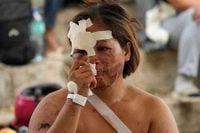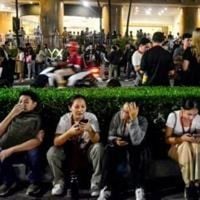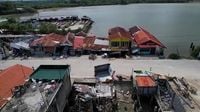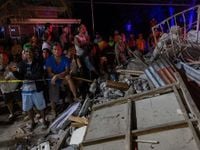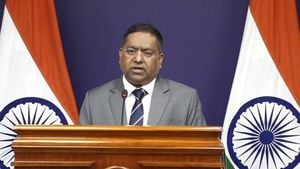Late on the night of October 1, 2025, a powerful 6.9-magnitude earthquake struck Cebu province in the central Philippines, leaving devastation in its wake. By Thursday, October 3, the death toll had climbed to at least 72, with nearly 300 people injured and tens of thousands more reeling from the aftermath, according to figures from the National Disaster Risk Reduction and Management Council (NDRRMC) and reports from The Associated Press and Xinhua.
The quake, which struck at 9:59 p.m. local time, caught many residents off guard as they settled in for the evening. The epicenter was traced to a shallow undersea fault line, one that Filipino seismologists said had not moved for at least 400 years. The sudden rupture sent violent tremors through Bogo City—a coastal city of about 90,000—and surrounding towns, toppling buildings, collapsing bridges, and leaving a port in ruins.
"I went around the rubble and kept calling out their names," Isagani Gelig told The Associated Press as he stood beside the remains of the Condor Pension House, a budget hotel in Bogo where his wife and four-year-old son John had been trapped. Firefighters eventually brought out their bodies in black cadaver bags, and a rescuer handed Gelig a cellphone found with his wife’s body. He nodded in recognition, confirming it was hers. The heartbreak of families like Gelig's resonated throughout the province, as survivors recounted moments of terror and loss.
According to the NDRRMC, the fatalities were spread across several municipalities: 30 in Bogo City, the hardest-hit area; 22 in San Remigio; 12 in Medellin; five in Tabogon; and one each in Sogod, Tabuelan, and Borbon. The number of injured stood at 294, with more than 170,000 individuals affected overall. Many residents refused to return to their homes, traumatized and fearful of aftershocks that continued to rattle the region.
In the aftermath, the provincial government declared a state of calamity, a move that enabled local authorities to quickly mobilize emergency funds and impose price freezes on essential goods. This declaration was crucial for providing immediate relief and rehabilitation to the tens of thousands displaced. According to Xinhua, 47,221 families—amounting to 170,959 individuals—were affected, and 87 infrastructures along with 597 houses were either damaged or destroyed.
The devastation was not limited to private homes. Bogo’s seaport collapsed, bridges and concrete roads cracked, and public buildings suffered extensive damage. In San Remigio, just outside Bogo, a gymnasium ceiling gave way during the quake, killing three coast guard personnel and a firefighter. Bryan Sinangote, a 49-year-old driver who survived the collapse, described the chaos: "Everybody froze. When the up-and-down shaking became intense, everybody dashed out of the gym in panic." Sinangote was partly trapped but managed to survive, thanks to the quick response of coast guard members. He recounted his resilience in the face of repeated disasters, recalling how Typhoon Haiyan had destroyed his house in 2013. "After Typhoon Haiyan destroyed my house, I built it back in one year," he said. "We just have to be prepared for anything."
The earthquake also claimed the life of a local hero. Ian Ho, a 49-year-old Red Cross volunteer and highly trained first responder, was found dead in the rubble of his collapsed home, embracing his 14-year-old son, who survived. Red Cross Secretary-General Gwendolyn Pang reflected on his sacrifice: "He chose to be the shield of his son. This is the kind of people that we have, lifesavers with an innate instinct to help other people. In this case, the last person that he saved was his son."
President Ferdinand Marcos Jr. arrived in Bogo on Thursday, October 3, to witness the destruction firsthand. He visited damaged homes and buildings, offered cash and medical aid to survivors, and mourned with the families of those lost. The president promised that clusters of tents would be erected for thousands of residents who had been displaced. His visit was a visible sign of the government’s commitment to recovery, but the scale of the disaster meant that local and international help would be needed for months to come.
The United States, a longstanding treaty ally of the Philippines, was among the first to offer assistance. China and Japan also expressed their condolences, underscoring the international community’s readiness to support the Philippines in times of crisis. The country’s vulnerability to natural disasters is well known—its location along the Pacific "Ring of Fire" means it is frequently rocked by earthquakes and volcanic eruptions, and it endures about 20 typhoons or storms every year. Disaster preparedness and response are perpetual challenges for both the government and volunteer organizations.
For many families, the trauma of the earthquake was compounded by the uncertainty of what comes next. With aftershocks continuing to shake the region, some residents have refused to return to their homes, instead seeking shelter in makeshift tents or with relatives in safer areas. The declaration of a state of calamity allowed the government to fast-track emergency measures, but the road to recovery will be long.
As the dust settles and rescue operations wind down—disaster officials said there were no more reports of missing persons and search efforts had ended—the focus shifts to rebuilding and healing. The stories of loss and heroism, of families torn apart and communities rallying together, are reminders of the resilience that defines the Filipino spirit. But for those who lived through the quake, the memories of that night will linger long after the physical scars have faded.
In the heart of Bogo, as clusters of tents rise and the community begins to piece itself back together, the hope is that the lessons learned from this disaster will help build a safer, stronger future for all those living on the edge of the Pacific’s restless ring.
